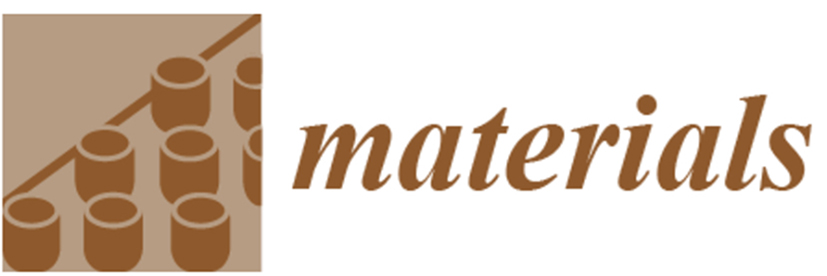ISSN (online): 1996-1944
Call of the Journal:
- Advanced Carbon Materials in Water Treatment or Separations Technology
- Advanced Functional Hybrid Materials for Novel Biomolecular Electronics
- Advances in Biomaterials | Design, Synthesis, Characterisation and Biomedical Application
- Advances in Construction and Building Materials
- Advances in Green Construction Materials
- Assessment of Metallurgical and Mechanical Properties of Welded Joints via Numerical Simulation and Experiments
- Carbon Compounds-Reinforced Ceramics
- Concrete and Waterproofing Materials | Development of Waterproofing Technology for Buildings and Civil Concrete Structures
- Corrosion Inhibitors for Steel | Experimental and Theoretical Studies
- Damage and Failure of Polymers, Polymer-Like Materials, Adhesives and Polymer Nanocomposites
- Development of Energy Storage or Conversion Element Based on Various Nano Materials
- Dyes | Synthesis, Properties, and Applications
- Dynamic Behavior of Ceramic Composites
- Flexible Sensors and Actuators for Novel Wearable Solutions
- Fundamentals and Applications of Bionano Sensor Techniques
- Graphene Foam Based Composites
- Growth and Application of Foam-Based Materials
- High Performance Concrete
- Hybrid Noble Metal/Graphene Aerogels | Synthesis, Characterization and Applications for Chemical Sensing and Biosensing
- Hydrogen Storage and Fuel Cells | Materials, Characterization and Applications
- Load Test and Numerical Analysis on Construction Materials
- Machining and Surface Properties of Steel Parts
- Materials under Extreme Conditions | Technologies for CRMs Reduction, Substitution and Recovery
- Microplastics and Nanoplastics | From Resource to Pollution
- Mineral-Bonded Composites for Enhanced Structural Impact Safety
- Modification and Processing of Biodegradable Polymers
- Nanostructured Semiconductors for Photoinduced Applications
- Novel Inorganic Adsorbents for Environmental Purification
- Numerical Simulation and Experimental Studies of Wave Phenomena in Composite Materials
- Performance Research of Polyurethane Foams and Composites
- Physics, Electrical and Structural Properties of Dielectric Layers
- Precision and Ultra-Precision Subtractive and Additive Manufacturing Processes of Alloys and Steels
- Processing and Thermal Properties of Hybrid Composites
- Recent Advances in 3D Printing for Biomaterials
- Recent Progress in the Development, Material Properties, and Post-Processing of Additively Manufactured Components
- Silica and Silica-based Materials for Biotechnology, Polymer Composites and Environmental Protection
- Study on the Modification and Compressive Properties of Concrete Buildings Materials
- Superconductors for Opto-Nano and Micro-Electro-Mechanical Systems (O-N/MEMS)
- Synthesis and Characterization of Hybrid Nanomaterials and Nanocomposites
- Synthesis, Properties and Applications of Polymer Blends
- Testing of Materials and Elements in Civil Engineering
- The Science and Technology of 3D Printing
Jan
2021
Mar
2021
Thanks to the development of the automotive and aerospace industries at the turn of the 20th and 21st centuries, it was shown that topography—more broadly, the geometry of surfaces (SGP) – has extremely high importance for the utility of manufactured elements. It also emerged that the measured surface is more complex, and its description should include not only include altitude/amplitude parameters but also other normalized parameters which are not included in the standards, e.g., fractals and wavelets. Surface geometry measurements and tests can serve different purposes, but it was experimentally proven that these parameters influence the friction and wear of interacting surfaces; deformation and contact strength; stresses and their concentration; corrosive reactions; tightness of connections; deposition quality, adhesion, and durability of coatings; and aero- and hydrodynamic properties. In mentioning surface or the geometric structure of the surface, we must remember its functional properties (its functionality), which is closely related to its topography (stereometry), depending on the method of processing. Nowadays, the technological shifts in surface metrology allow the surface features generated by modern manufacturing processes (including hard part machining) to be characterized with a higher accuracy using a number of the areal field parameters (S-parameters and V-parameters sets).
Keywords: surface metrology; surface topography; areal parameters; machining operation; precision manufacturing; friction.
Machining and Surface Properties of Steel Parts
Thanks to the development of the automotive and aerospace industries at the turn of the 20th and 21st centuries, it was shown that topography—more broadly, the geometry of surfaces (SGP) – has extremely high importance for the utility of manufactured elements. It also emerged that the measured surface is more complex, and its description should include not only include altitude/amplitude parameters but also other normalized parameters which are not included in the standards, e.g., fractals and wavelets. Surface geometry measurements and tests can serve different purposes, but it was experimentally proven that these parameters influence the friction and wear of interacting surfaces; deformation and contact strength; stresses and their concentration; corrosive reactions; tightness of connections; deposition quality, adhesion, and durability of coatings; and aero- and hydrodynamic properties. In mentioning surface or the geometric structure of the surface, we must remember its functional properties (its functionality), which is closely related to its topography (stereometry), depending on the method of processing. Nowadays, the technological shifts in surface metrology allow the surface features generated by modern manufacturing processes (including hard part machining) to be characterized with a higher accuracy using a number of the areal field parameters (S-parameters and V-parameters sets).
Keywords: surface metrology; surface topography; areal parameters; machining operation; precision manufacturing; friction.
ADS-Astrophysics Data System, AGORA(FAO), CAB Abstracts(CABI), Chemical Abstracts (ACS), Current Contents-Engineering, Computing & Technology (Clarivate Analytics), DOAJ, Ei Compendex/Engineering Village (Elsevier), Genamics JournalSeek, Global Health (CABI), HINARI (WHO), Inspec (IET), Journal Citation Reports/Science Edition (Clarivate Analytics), Julkaisufoorumi Publication Forum (Federation of Finnish Learned Societies), Norwegian Register for Scientific Journals, Series and Publishers (NSD), Polymer Library (Smithers Rapra), PubMed (NLM), Science Citation Index Expanded – Web of Science (Clarivate Analytics), Scopus (Elsevier), Web of Science (Clarivate Analytics), Zetoc (British Library), CLOCKSS (Digital Archive), e-Helvetica (Swiss National Library Digital Archive), PubMed Central (NLM), Academic OneFile (Gale/Cengage Learning), EBSCOhost (EBSCO Publishing), Energy & Power Source (EBSCO), Engineering Source (EBSCO), Google Scholar, J-Gate (Informatics India), Materials Science & Engineering (ProQuest).
Info at: www.mdpi.com/journal/materials/apc
Guest Editor
Prof. Krzysztof Żak









